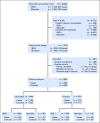Impact of a Panel of 88 Single Nucleotide Polymorphisms on the Risk of Breast Cancer in High-Risk Women: Results From Two Randomized Tamoxifen Prevention Trials
- PMID: 28029312
- PMCID: PMC5455424
- DOI: 10.1200/JCO.2016.69.8944
Impact of a Panel of 88 Single Nucleotide Polymorphisms on the Risk of Breast Cancer in High-Risk Women: Results From Two Randomized Tamoxifen Prevention Trials
Abstract
Purpose At least 94 common single nucleotide polymorphisms (SNPs) are associated with breast cancer. The extent to which an SNP panel can refine risk in women who receive preventive therapy has not been directly assessed previously. Materials and Methods A risk score on the basis of 88 SNPs (SNP88) was investigated in a nested case-control study of women enrolled in the International Breast Intervention Study (IBIS-I) or the Royal Marsden study. A total of 359 women who developed cancer were matched to 636 controls by age, trial, follow-up time, and treatment arm. Genotyping was done using the OncoArray. Conditional logistic regression and matched concordance indices (mC) were used to measure the performance of SNP88 alone and with other breast cancer risk factors assessed using the Tyrer-Cuzick (TC) model. Results SNP88 was predictive of breast cancer risk overall (interquartile range odds ratio [IQ-OR], 1.37; 95% CI, 1.14 to 1.66; mC, 0.55), but mainly for estrogen receptor-positive disease (IQ-OR, 1.44; 95% CI, 1.16 to 1.79; P for heterogeneity = .10) versus estrogen receptor-negative disease. However, the observed risk of SNP88 was only 46% (95% CI, 19% to 74%) of expected. No significant interaction was observed with treatment arm (placebo IQ-OR, 1.46; 95% CI, 1.13 to 1.87; tamoxifen IQ-OR, 1.25; 95% CI, 0.96 to 1.64; P for heterogeneity = .5). The predictive power was similar to the TC model (IQ-OR, 1.45; 95% CI, 1.21 to 1.73; mC, 0.55), but SNP88 was independent of TC (Spearman rank-order correlation, 0.012; P = .7), and when combined multiplicatively, a substantial improvement was seen (IQ-OR, 1.64; 95% CI, 1.36 to 1.97; mC, 0.60). Conclusion A polygenic risk score may be used to refine risk from the TC or similar models in women who are at an elevated risk of breast cancer and considering preventive therapy. Recalibration may be necessary for accurate risk assessment.
Figures


Comment in
-
Improving Breast Cancer Risk Assessment Versus Implementing Breast Cancer Prevention.J Clin Oncol. 2017 Mar;35(7):702-704. doi: 10.1200/JCO.2016.70.9386. Epub 2016 Dec 28. J Clin Oncol. 2017. PMID: 28029306 No abstract available.
-
SNPs for breast cancer risk assessment.Oncotarget. 2017 Nov 3;8(59):99211-99212. doi: 10.18632/oncotarget.22278. eCollection 2017 Nov 21. Oncotarget. 2017. PMID: 29245890 Free PMC article. No abstract available.
References
-
- Cox A, Dunning AM, Garcia-Closas M, et al. A common coding variant in CASP8 is associated with breast cancer risk. Nat Genet. 2007;39:352–358. - PubMed
-
- Stacey SN, Manolescu A, Sulem P, et al. Common variants on chromosomes 2q35 and 16q12 confer susceptibility to estrogen receptor-positive breast cancer. Nat Genet. 2007;39:865–869. - PubMed
-
- Stacey SN, Manolescu A, Sulem P, et al. Common variants on chromosome 5p12 confer susceptibility to estrogen receptor-positive breast cancer. Nat Genet. 2008;40:703–706. - PubMed
Publication types
MeSH terms
Substances
Grants and funding
LinkOut - more resources
Full Text Sources
Other Literature Sources
Medical

